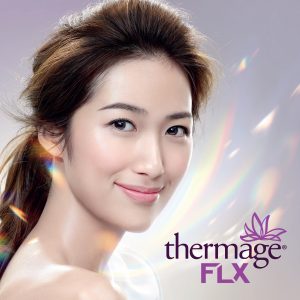Non-Surgical Skin Tightening

We offer non-surgical skin tightening primarily via energy based devices.
There are many approved devices available in the market that aim to deliver skin tightening without surgery.
All devices utilize some form of energy deliverance, with radiofrequency (RF) and ultrasonic energy being the commonest types.
Energy when delivered appropriately into the appropriate level of the skin results in heat generation and stimulates the production of collagen. The collagen production typically takes 3 to 6 months to reach optimal levels and results in the skin tightening effects.
Energy based skin tightening devices are typically targeting mild to moderate degrees of laxity, and generally deliver mild to modest improvement in the laxity.
All energy based skin tightening devices will inflict some degree of pain, ranging from mild discomfort to severe pain depending on the specific device and energy settings. Prior adequate numbing with topical numbing creams is routinely required. And all energy based skin tightening devices have a risk of causing burns.
At YVL Medical Aesthetics, our main modalities are the Thermage FLX, which is a mono-polar RF device and the Sofwave, which is an ultrasonic device.

Thermage FLX is the latest version of the Thermage machine, which has been used for over a decade for RF skin tightening globally. It basically involved repeated applications and firing of a single-use Thermage tip in a sequential and repetitive fashion to the treatment area. Treatment tips can be divided into the Eye Thermage Tip which has a 0.25cm2 surface area, and the Face Thermage Tip which has a 4.0cm2 surface area. All Thermage tips must be used in a single session, as once activated, each tip only has an active lifespan of 4 hours.
Eye Thermage
We normally use the 450-rep tip for treating the eye. The Eye Thermage tip is specifically designed for treating the upper and lower eyelid and the periorbital region in general. The penetration of the RF energy is significantly shallower compared to the Face Thermage tip, hence sparing the eyeball. Nevertheless, prior to performing Eye Thermage treatment, we apply numbing cream around the eyelids, administer anaesthetic eyedrops to the eyes and place a corneal shield to protect the eyeball. It is an effective procedure for treating mild to moderate degrees of laxity of the upper eyelid, lower eyelid, and periorbital region, as well as fine lines. The upper eyelid is a particularly difficult area to treat, and many other devices are unable to treat the upper eyelid specifically. Of note, the pain levels associated with Eye Thermage are mild and tolerable, even at energy levels of 4.0 to 5.0 (5.0 being the maximum for Eye Thermage), as the tip size is small.
Face Thermage
We normally use the 600-rep or 900-rep tip, depending on whether the neck is to be treated in addition to the face. Mild to moderate laxity of the face and neck is the commonest reason for performing Face/Neck Thermage. The same tip can be used to treat abdominal wall and buttock laxity as well. Unlike Eye Thermage, the pain levels associated with Face Thermage is significantly greater. Prior to performing Face Thermage, we apply a combination numbing cream for 1 to 2 hours to the treatment areas and pre-medicate with analgesics but despite that, the pain level is considered substantial to most. The Face Thermage energy settings can go up to 8.0. Here’s how the energy levels pan out in a real-world setting:
3.0 – considered tolerably painful by most
4.0 – for those who have good pain thresholds
5.0 – for the exceptional few
5.5 – our current record
6.0 to 8.0 – probably best reserved for Black Ops interrogation.
We often tell patients that Eye Thermage is like taking a 30-minute stroll in the park; you’d work up a good sweat but generally feel good. Whereas Face Thermage is like trying to do a 10km run; it’ll probably start hurting after 3 minutes and you’d have to endure through the rest of the remaining hour!
Pain feedback has been established as a valid means of assessing treatment adequacy in Face Thermage, hence one should not be fixated by the energy levels one is receiving. Tolerably painful is the desired level, be it 3.0 or 5.0.
All ultrasonic skin tightening devices deliver ultrasonic waves (energy) to the deep dermis and/or subcutaneous tissue and converting to heat energy in the process.
Heat energy results in the contraction of existing collagen and elastin, resulting in an immediate but mild tightening of the treatment area, and provides the stimulus for new collagen and elastin production, resulting in the eventual tightening/lifting best seen at 3 to 4 months post-treatment.
The classical method of ultrasonic energy delivery involves multiple ultrasonic waves converging at fixed points in the deep dermis and subcutaneous tissue. At the foci where the ultrasonic waves converge, the most heat energy is generated. The multiple foci are spread out at fixed intervals, resulting in a fractional effect. This is commonly referred to as High Intensity Focused Ultrasound (HIFU) which can be painful due to the convergence of ultrasonic waves. There is also a small risk of nerve injury from the convergence of ultrasonic waves.
Newer generation ultrasonic skin tightening devices have started to adapt new methods of delivering ultrasonic energy that no longer involve wave convergence.
At YVL Medical Aesthetics, we use the Sofwave device, which utilizes their own proprietary Synchronous Ultrasound Parallel Beam Technology (SUPERB), whereby the ultrasonic waves are fired off as parallel beams that do not converge. Each treatment pulse fires seven parallel beams targeting the deep dermis and allows for even heating of the treatment area. As the ultrasonic beams do not converge, the amount of pain involved is lesser and generally well tolerated by our patients. The risk of any accidental injury to nerves or surrounding tissue is greatly reduced due to the non-convergence of the ultrasound waves.
It is also a convenient treatment that typically takes 30 minutes to administer.

